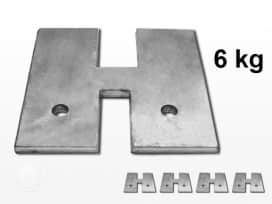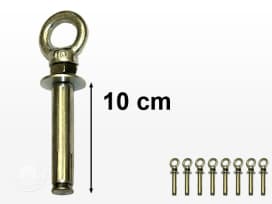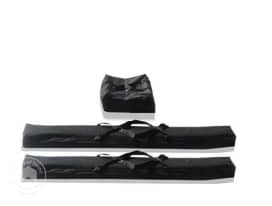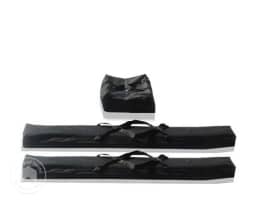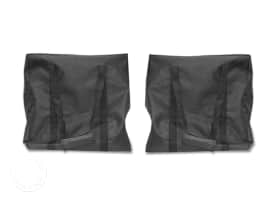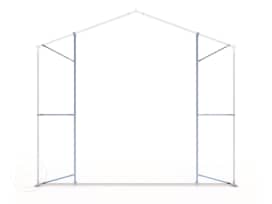
Storm Protection

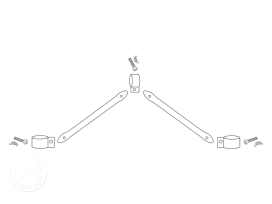






Tie Down Kits - Your tent accessories
Our customers have different needs according to how long, and in what kinds of weather they will use their tents. If you are planning on leaving your marquee or gazebo up for a longer period, or want to be prepared for all kinds of bad weather, a tie down kit is a great idea. The kit will protect your tent and property, prevent wear, and leave you with greater peace of mind when the wind picks up. If you are asking yourself, what are tie down kits, what is included, and which kit is suitable for marquees as opposed to gazebos or portable garages, this guide will provide you with the answers.
A tie down kit is a fastening system consisting of ground anchors, tension belts and ratchet tensioners. They come in handy as well as load restraints, for securing and transporting loose, bulky goods.
Tie down kits greatly improve the stability and strength of tents. They also provide ultimate protection, decreasing the risk of storm or wind damage and even lessen noise inside the tent. At House of Tents you will find ratchets, pegs and heavy duty straps for all of our products included in the pack!

Does every tent need storm protection?
Normally, in calm or light winds, the standard anchors and guy ropes included in delivery of your tent, sufficiently protect the structure. However, in the event of a storm or strong gusts of wind, there is a risk of a tent being whirled through the air, damaging not only the tent, but putting your property, friends and family at risk. For this reason, tie down straps are a recommended accessory for all tent designs. Belts provide essential protection for tents that are left standing over winter. The improved stability makes it possible to leave a tent standing even in changeable, windy weather and reduces the risk of storm damage as well as normal wear and tear.
Tents purchased with House of Tents' Safety plus package include an engineer's report in which maximum loads (in kg per square metre) have been calculated. You will have a better idea whether dismantling is necessary. Tents with the Safety plus package do not require additional tie down straps, but can be secured beyond the load limits calculated by engineers with additional belts from this kit.
Tents should be dismantled in high winds
Even with tie downs, our tents are not hurricane proof! In extreme weather conditions such as severe storms or hurricanes, which could have a devastating impact, we always advise dismantling your tent.
What tie down kits do you have in stock at House of Tents?
Tie down kits are available for soft grounds (grass or soil) and for hard surfaces (concrete or asphalt). While it's usually clear whether the surface you are standing on is hard or soft, this sometimes requires a bit of thought. For instance, paving stones, while hard, are not a suitable anchoring surface for a tent. In the case of paving stones we recommend you using soft ground anchoring pegs to anchor the tent to the ground between stones or beyond the paved area.
Depending on the type of tent - pop up gazebo, marquee, storage tent, field shelter, farm storage tent, tent garage or industrial tent - the method of strapping the tent down with belts differs. Some structures are completely tensioned over the tent roof by means of a tensioning strap, while others use ratchet straps that are attached to the frame at the corners.
How do you secure your tent with tensioning belts?
To install the belts, you should first start with the pegs. Fasten the pegs or concrete anchors in the ground at the side of your tent. For soft ground anchors we recommend that you place the pegs deep into the ground - between 400-600 mm deep. Concrete anchors should be fixed to the concrete surface. A hole must be predrilled for this purpose. The concrete anchors are fully galvanised metal frame anchors with an expansion function.
In the case of a marquee or storage tent with a side height of 2 metres, the distance between the ground anchor and the pavilion should be roughly 2 metres, so that an angle of 45 degrees is created when the ratchet straps are tensioned. Secure the ground anchorage to the tent frame via the tensioning belts and fix the belt tension with ratchet tensioners. Position the belt over the tent, being careful to protect the tent fabric from damage. For best results, try to ensure that the belt doesn't twist. Use the S-Hooks to hook the straps to the anchors and then use the adjustable belt tensioner (ratchet) to lock in the correct tension. The belt tension should be firm without putting an excess load on the tent frame and wear on the tarpaulin. We advise checking the belt tension regularly and retensioning the straps when necessary.

Ensuring your pop up gazebos & tent garages can withstand the elements
At House of Tents we also have options for you to firmly tie pop up gazebos to the ground. This set includes storm straps with a length of 10 metres and a belt span of roughly 50 mm, ratchet tensioners and 40 cm long pegs. When storing your automobile, the stability of the portable garage is naturally an important consideration. Therefore, on this page you will find a specific set of tension belts designed for use with our portable garages. The ground pegs of this 50 mm wide belt set are 60 cm long and also consist of a full steel profile. In total, this storm protection set for tent garages has 4 ground anchors, each 60 cm long, 2 ratchet tensioners and 2 storm straps with hooks on the ends approximately 15 metres in length. Now you have a mobile shelter for your car that is not only waterproof, weatherproof and a much cheaper alternative to rented indoor spaces, but a structure that is also extremely stable.
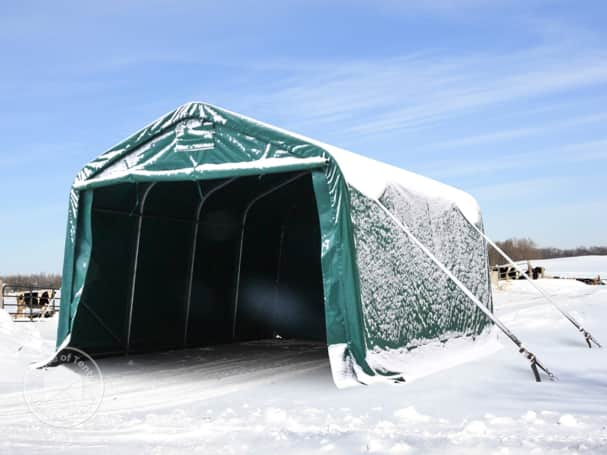
Alternatives to tie down straps
What do you do if you are not allowed to drill into the ground or you want to be more mobile, without having to untie the straps, and tie them again when you move the tent? In these cases you should consider an alternative for keeping your tent safe and grounded. The solution: Special ground fixings for pop up gazebos, marquees and storage tents from House of Tents.
These fixings include, for example, a set of four 6 kg foot plates that can be used for Marquees from the Economy and Premium product lines as well as for Professional marquees with PE tarpaulins. Using these specially designed feet allows you to weigh down the structure even further with concrete slabs. This greatly improves stability without the need to drill into the ground. Base frames also increase the stability of a storage tent or marquee, giving you plenty of options to tie the frame down. In addition, a base frame reduces noise and movement, as it allows you to tie side panels to the frame.
For pop up gazebos, weight bags and weighted metal plates are available to improve stability. These can be attached with ease to the legs or feet of the stand.
Some alternative anchoring options
What else influences the stability of your tent?
The surface on which your tent stands plays a role in the anchoring. The more firmly the anchoring is fitted into the ground, the more stable the tent is. For example, fine sand provides more friction and better anchorage than pebbles.
The location of your tent also plays a role on the stability, and the need for good anchoring. If you set up a storage tent or marquee in a wind-protected location, for example, it will stand more securely than on an open field. After all, a site with trees and walls reduces the force of wind working on the tent.
Similarly, it is advisable to keep a tent closed when the wind is strong outside. A closed tent cannot be lifted by a surge of wind as easily as an open one.
Another factor is the frame of a marquee or storage tent. A heavy duty tent with a base frame and roof supports is more stable and also weighs more. The heavier a tent is, the more stable it is as a rule.
In summary
Ratchet straps give your tent a higher stability and can lessen noise from wild weather. They are recommended both for tents used for the short-term and long-term. Even heavy tents that already feature some form of storm protection will benefit from additional belts. With storm protection ties you are prepared for unexpected changes in the weather or sudden strong gusts and can continue to use your tent in peace.
Do you have further questions about these tent accessories? Are you still looking for the right tent solution for your party? We have 1000s of tents in stock, as well as accessories and spare parts.
Expert advice


